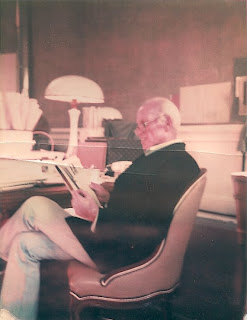I wrote an earlier post about John Dickinson, his style, his irreverent ideas, the book we had planned, and his untimely death.
I had a standing appointment at Dickinson’s San Francisco firehouse every Sunday morning at 9am. Over several years, I taped hours of conversations about his design, where he got ideas, his inspirations, his life, his work, his clients, his opinions on everything from lighting to humor in design, and from pattern (he thought it was a cop-out in décor), to color (he used it sparingly) to clients (indecisive and inattentive clients were a burden).
The color Polaroid below is one I took one afternoon in 1981. I had written a feature on John, and it had just been published. I drove over to the firehouse in Pacific Heights to show it to him. I happened to have a Polaroid camera (yes, a real Polaroid) with me. This image, which has been on my desk all these years, has never been published, never been seen.
In the blurry picture, John is sitting in a taupe-leather upholstered Victorian chair at his Art Déco table/desk. In the background are his signature lamps, the rolled up blueprints, his drafting table, the elegant amethyst-colored mottled walls (since painted over), and the distinctive light that spilled in from tall shuttered windows.
In this image (it seems like yesterday) he is wearing a navy bespoke Huntsman jacket, made in London, and off-white Gap chino pants.
“Cheap pants, Darlin’, only cheap pants,” he would say, to note his chic dressing style that mixed super-luxe cable cashmere sweaters and custom-crafted Savile Row jackets, with impeccable $20 Gap pants. This high/low combination, chic today, was highly unusual at that time. Like Andree Putman, he loved the mix of cheap and rich, luxury and utility.
Below, the black and white image of John Dickinson was photographed around the same time at the firehouse, by the Italian/Swedish photographer Victor Arimondi (sadly no longer with us).
 Black and white photograph of John Dickinson
Black and white photograph of John Dickinsonphotographed at his firehouse residence
in San Francisco by Victor Arimondi.
I had introduced Victor to John, and Victor would stop by the firehouse, shooting John at work drafting, or me typing on my portable Olivetti at the table, or elements of style in the skylit rooms.
In this never-published image, signed by Arimondi and given to me as a gift, John is indicating that the brass trim on his signature polished stainless steel fireplace, matches the trim along the wainscot.
Also in the picture: signature plaster tables, a phrenology head, and the accouterments of the John Dickinson style.
I’ve published comments John made during our hours of taping, in my books and in articles published over the years, as John Dickinson became an icon of design.
I taped years of conversations, redacted them at great length (we sometimes went off-topic), and edited the resulting quotes and observations. I sometimes see these published quotes in publications like auction catalogs and design magazine articles—and they are never correctly attributed. It always feels like a kind of theft, of a conversation, a moment, my work, and an idea I shaped and wrote.
Now John Dickinson’s plaster furniture turns up in top designers’ rooms, and in the galleries of top New York dealers like Liz O’Brien and Louis Bofferding, and at auction houses like Bonham’s and Sotheby’s.
When John was at the height of his career, he was never ‘popular’, and was never seen as iconic or collectible or even trend-setting. Some thought his work bizarre or even a bit frightening.Now it’s the mark of an in-the-know designer to have one of his metal skirted tables, a plaster tribal-influenced table, a console, a carved Stonehenge coffee table, or a twig lamp. The beat goes on.
Two photographs of John Dickinson at his 1893 firehouse residence on Washington Street in San Francisco. It may still be viewed today and looks precisely the same.


Photographs were taken by the great
San Francisco photographer,
Fred Lyon, and are used with permission.
San Francisco photographer,
Fred Lyon, and are used with permission.

